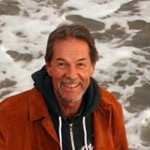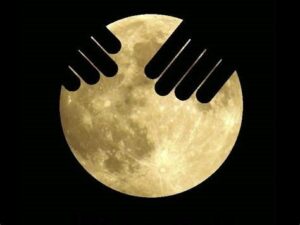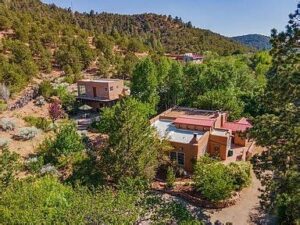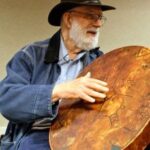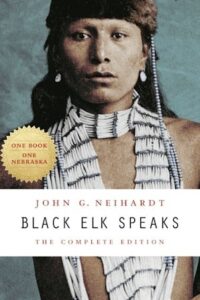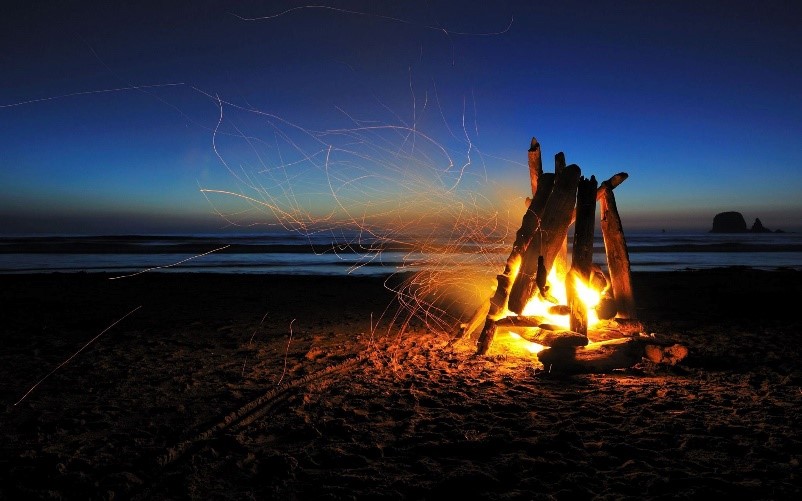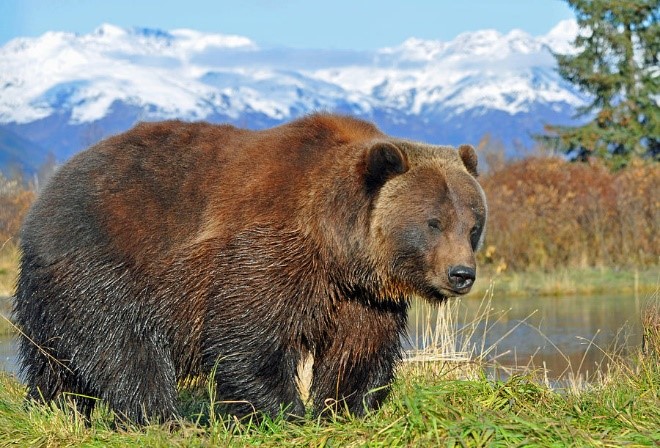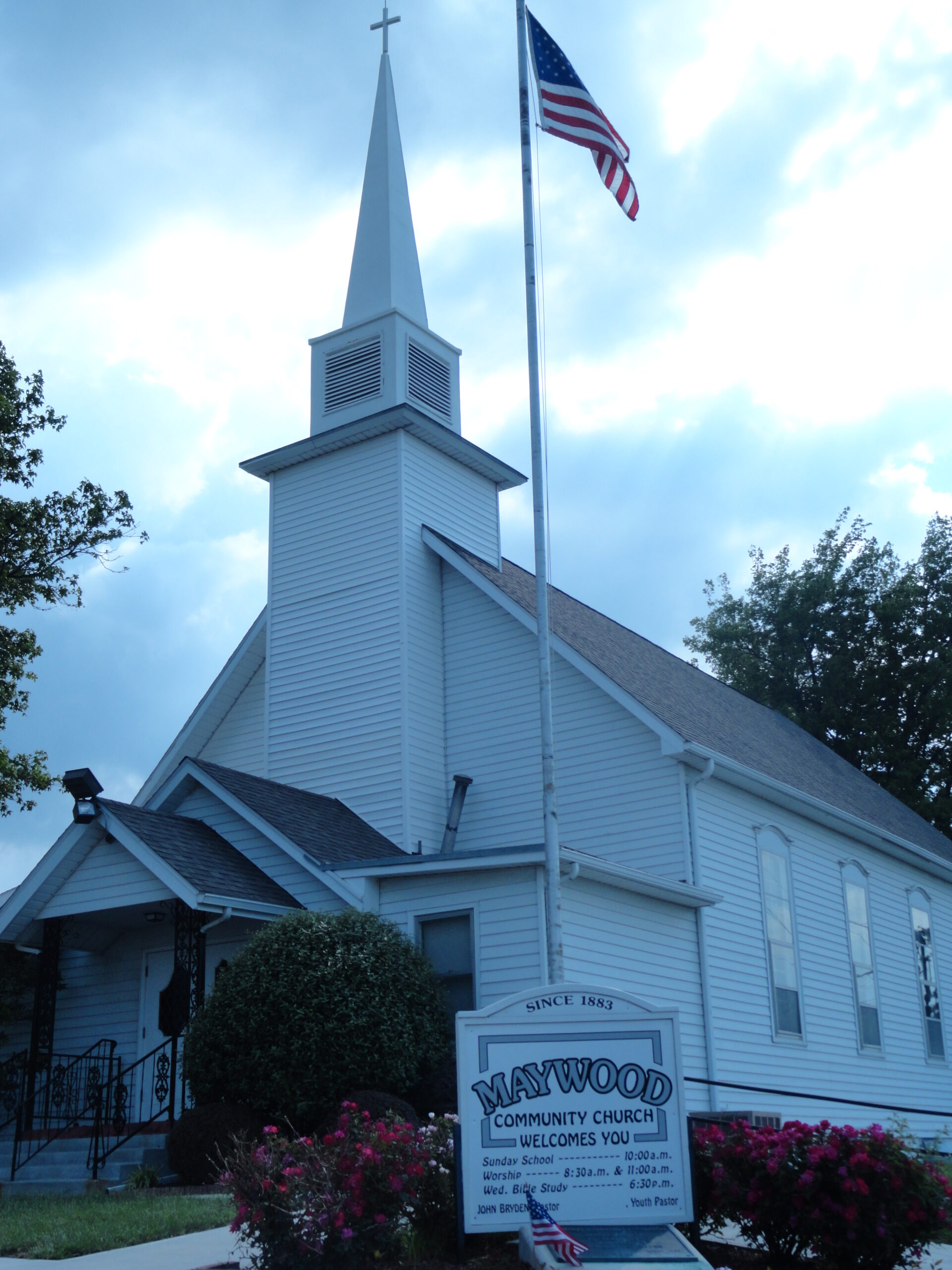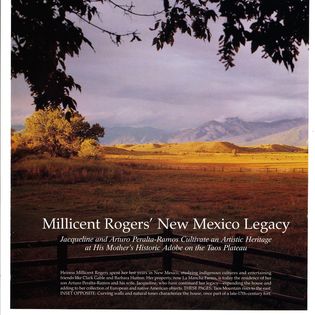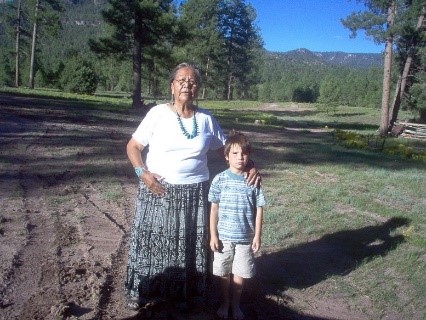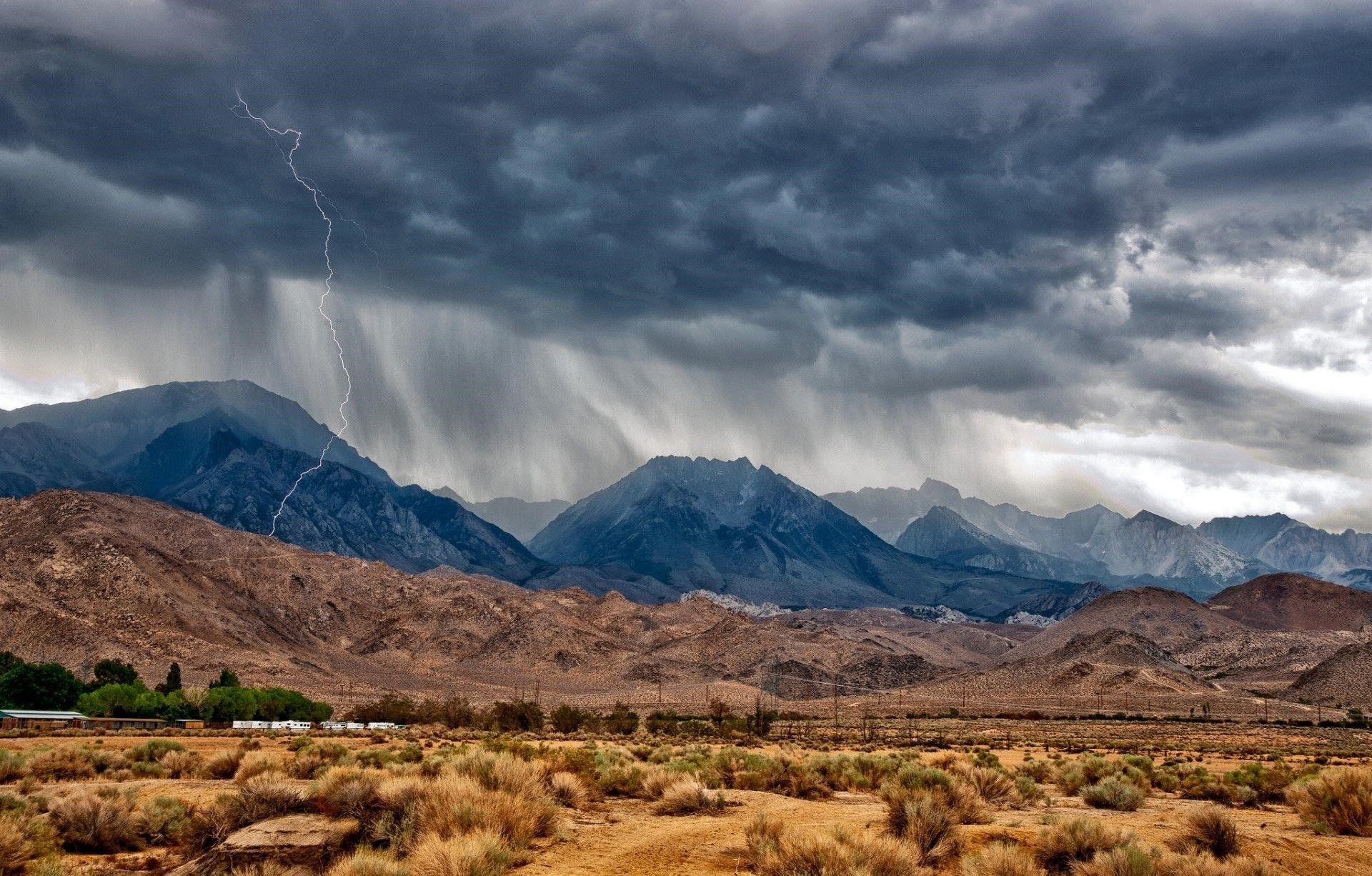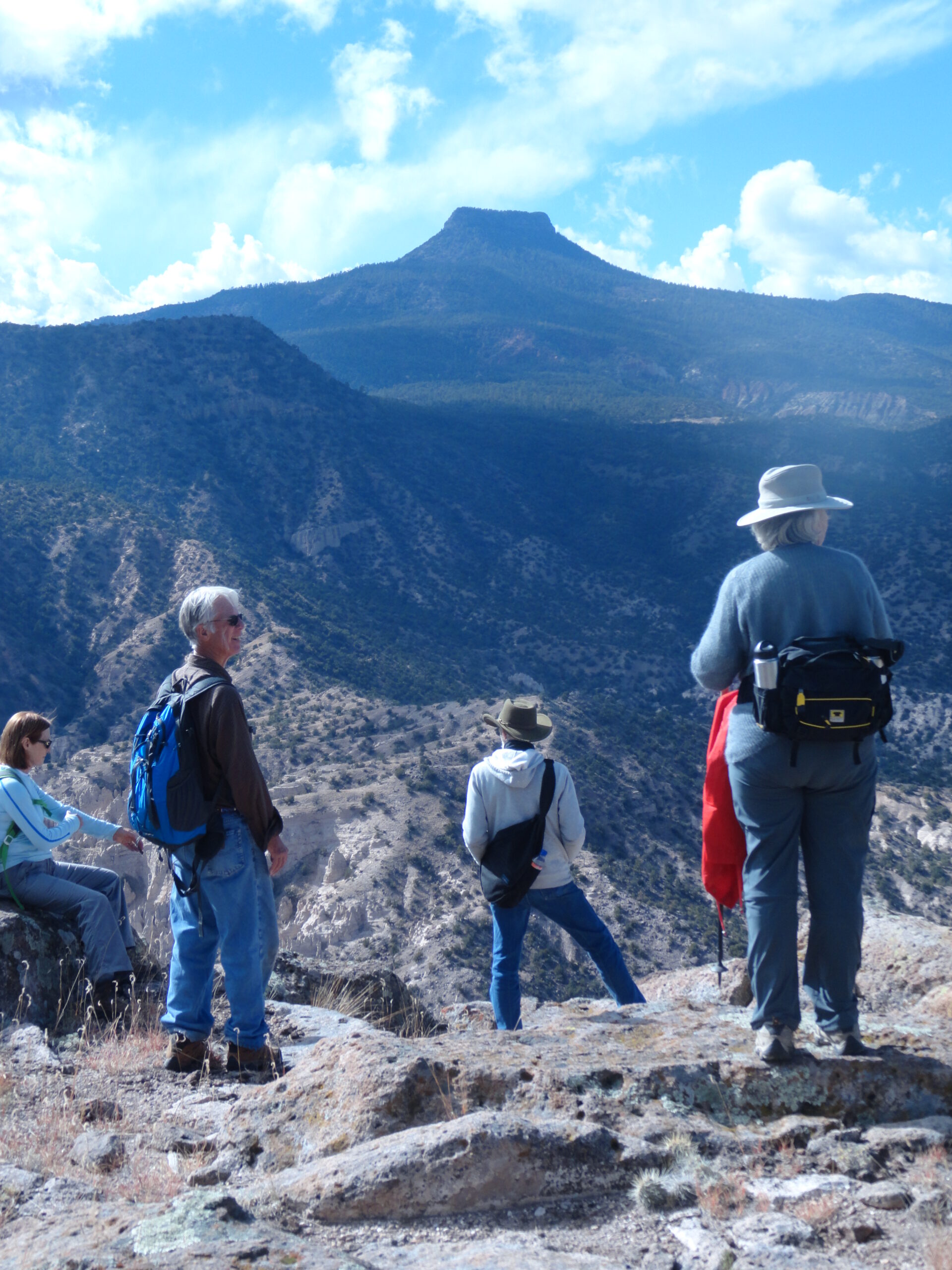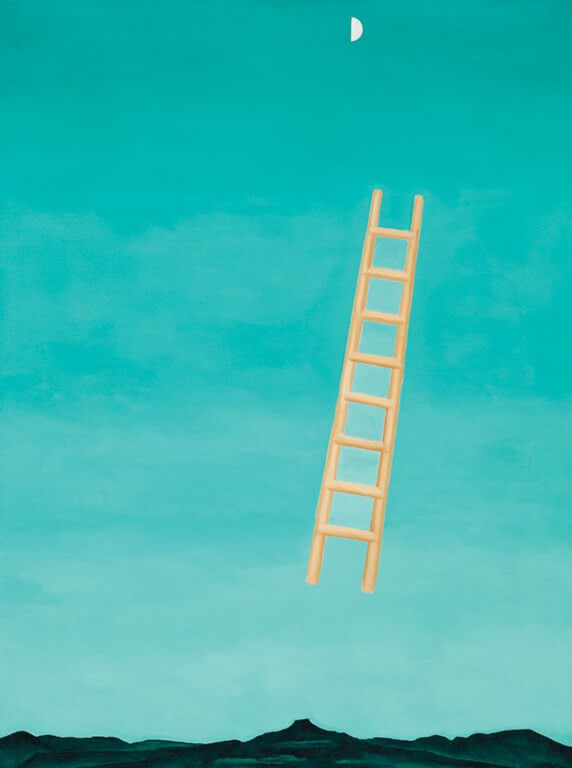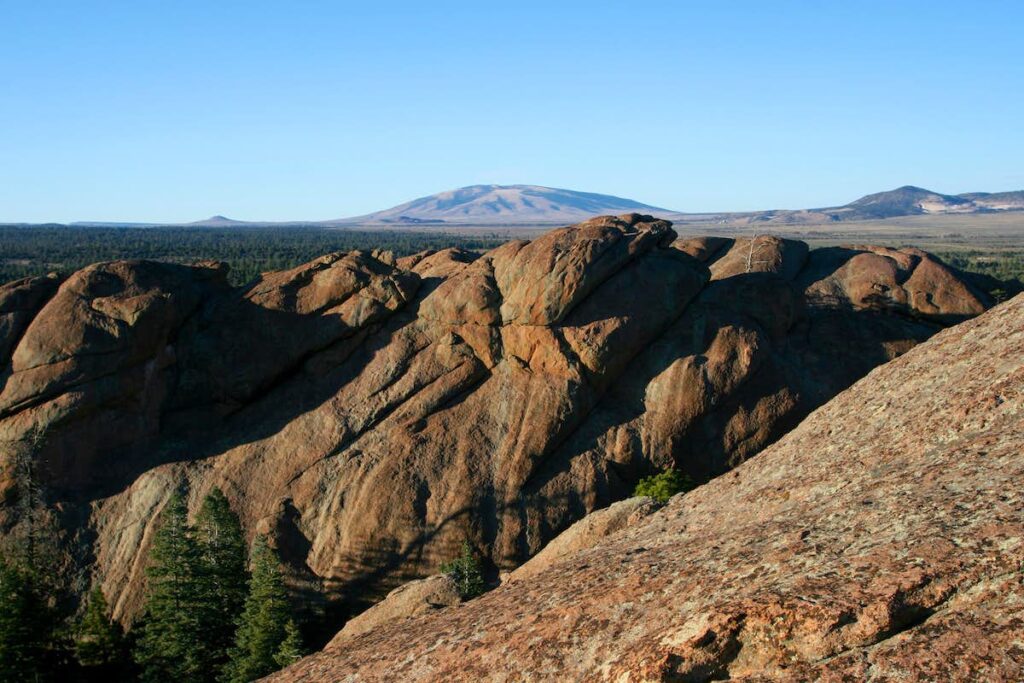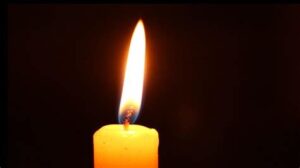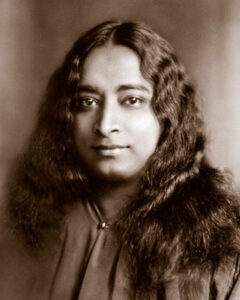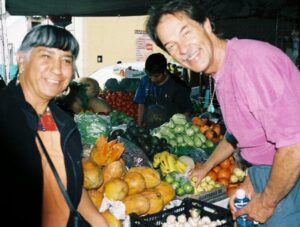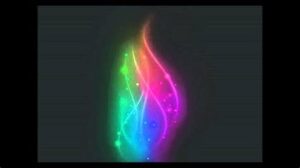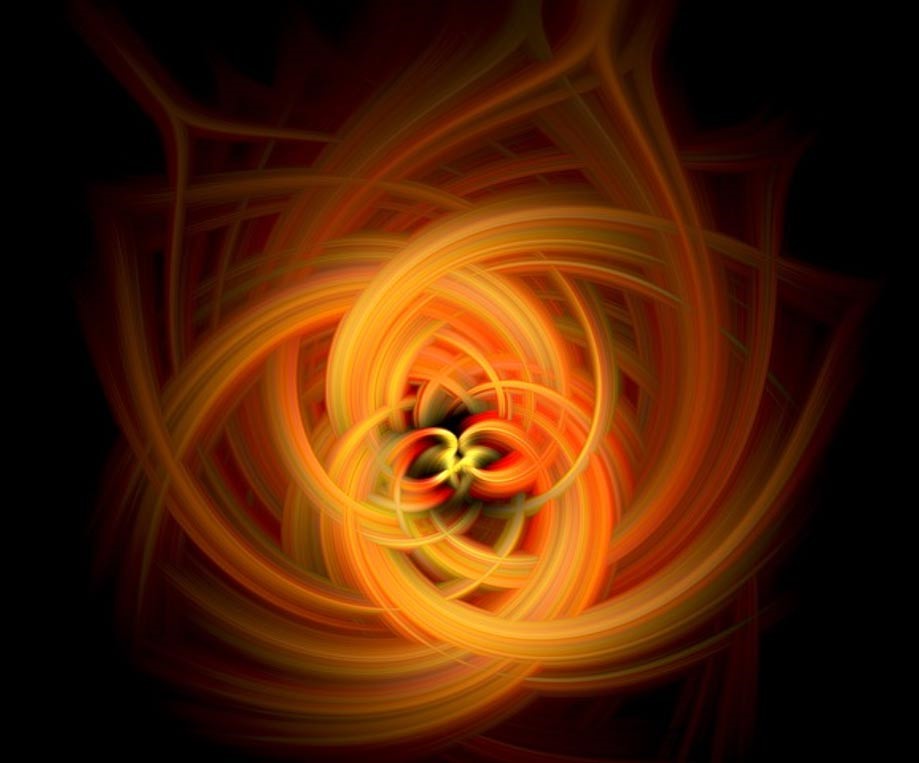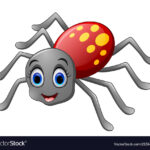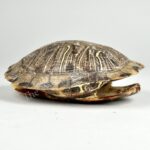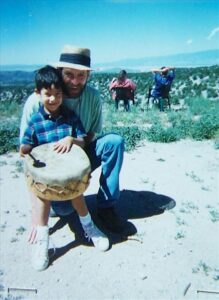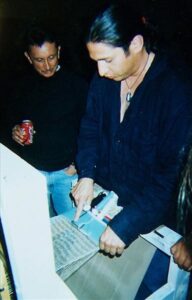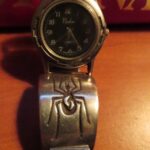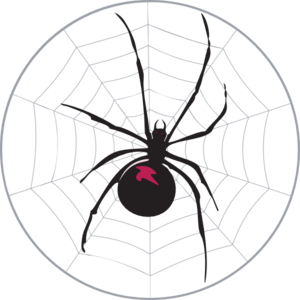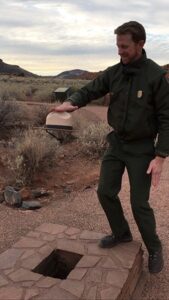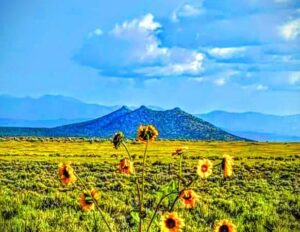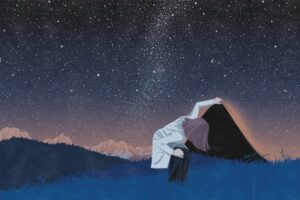Early morning, November 11, 1980 and the Chaco Canyon visitors’ center was not yet open. I sat in my car waiting. And watching. Watching a meditation in movement unfold in front of me on my first visit–more like a pilgrimage–to Chaco Canyon National Historical Park. A man was slowly, methodically and silently sweeping the entrance sidewalk, starting from one side and carefully making his way to the other. Not with a store-bought broom, but rather one that was handmade from brush and plants gathered in the area. Unlike me, the man was not in a hurry. He was slightly leaning, intent on each sweep of the broom, each passage down the sidewalk like a reverent monk at a Buddhist temple. There was no one else but us around in the silence save for we two and the early morning birds, unseen insects and other life forms waking up to the day. Deep breath, palms together, I bowed as Chaco greeted me, conveying a message and an image that I would carry with me with on numerous visits in the coming decades.
Chaco Canyon, a major center of ancestral Pueblo culture between 850 and 1250, was a focus for ceremonial, trade and political activity. It is remarkable for its monumental public buildings and distinctive architecture, the most exceptional concentration of pueblos and ancient ruins north of Mexico. Chaco is a great mystery play whose actors are the stars, sun, moon, the land and imagination and spirit of those who 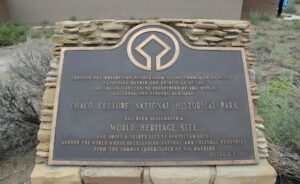 have made their way here over millennia. Both solar and lunar cycles were integrated into the architecture http://www.solsticeproject.org/lunarmark.htm and huge building sites were in alignment with each other over many miles. Great straight roads radiated out from the center of the canyon to distant outlying settlements. https://en.wikipedia.org/wiki/Archaeoastronomy#Chaco_Canyon
have made their way here over millennia. Both solar and lunar cycles were integrated into the architecture http://www.solsticeproject.org/lunarmark.htm and huge building sites were in alignment with each other over many miles. Great straight roads radiated out from the center of the canyon to distant outlying settlements. https://en.wikipedia.org/wiki/Archaeoastronomy#Chaco_Canyon
Many of the Indigenous people who guide Earth Walks groups consider Chaco as their ancestral home and approach the canyon with the respect that one has for a wise elder in the family. I am one of the countless thousands who feel an inexplicable kinship here as well. Over the more than 30 years of personal visits and leading Earth Walks groups to Chaco, my experiences have been unexpected and surprising, healing and transformational. I share some of these in the experiences that follow.
——————————-
August 15, 1986: I walked alone on a mesa ledge in Chaco Canyon 300 feet above the huge pueblo complex called Pueblo Bonito. 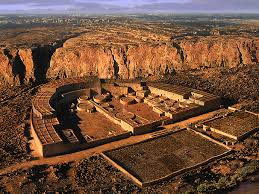 To get here wasn’t easy: a long winding trail from the parking area below, then a climb up a steep and narrow trail up through a slit in the sandstone mesa and still more walking. It took time and lots of effort but I needed to get up and out to view the vast open expanse of land and sky for inspiration and a break from my recurrent anxieties about income and loneliness. Those issues were oddly alternating with a deep feeling of abundance and contentment, issues I found reflected in this Chaco environment of sparse water, harsh climate and immense inspiration.
To get here wasn’t easy: a long winding trail from the parking area below, then a climb up a steep and narrow trail up through a slit in the sandstone mesa and still more walking. It took time and lots of effort but I needed to get up and out to view the vast open expanse of land and sky for inspiration and a break from my recurrent anxieties about income and loneliness. Those issues were oddly alternating with a deep feeling of abundance and contentment, issues I found reflected in this Chaco environment of sparse water, harsh climate and immense inspiration.
The winds of the canyon were just a gentle zephyr during my walk. Birds chirped from the cliffs around me. I heard my footfall step by step on the bare sandstone trail amidst the quiet of the canyon. I was walking a trail used hundreds of years ago by thousands of ancestral Pueblo people coming to this Center Place of the Chaco world. They traveled on constructed roads that radiated out in all directions, traversing a landscape barren of trees and water. The roads were wide and straight like highways leading sometimes to an identifiable goal, sometimes not. Huge earthen ramps were constructed when the road met a steep cliff.
I was not thinking about much, just enjoying the walk when the unexpected occurred. My long-deceased cousin Janis Hammer appeared in my mind. I had not thought much about her in recent years, even though she and I were the same age and were inseparable playmates. I didn’t have a sister and she was an only child so when we were together, which was often, we had wonderful fun. Janis died instantly in a car accident in which my brother was driving in El Paso. My brother was not at fault, and he almost died also because of the accident. I was deeply stunned at her loss and refused, as I recalled, to get out of the car to attend graveside services. I remembered sitting in my parents’ home after Janis’ death, not speaking, not crying, just being silent. Perhaps I never mourned her loss, not wanting to feel the pain of loss of someone so dear. Perhaps as a teenager I did not know how to grieve.
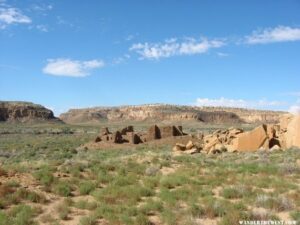
Photo by WandertheWest.com
Now, over 30 years later, in the remote desert of Chaco Canyon, Janis as a woman my own age came into clear inner view. Tears welled up in my eyes as I realized I indeed had never accepted her death. Overcome with emotion, I stopped walking, and turned to face an opening across the canyon called the South Gap. Through the space between the canyon walls, I could see an almost limitless horizon. And in the midst of the morning, surrounded by the unseen ancient ones of this place as witnesses and guides, I released Janis and her spirit to go where it needed to go. And I was freed as well to walk my path with my load a little lighter.
It was only later I learned that archaeologists discovered a huge mound of broken pottery on the north facing side of the site called Pueblo Alto where I walked. They speculated that Pueblo pilgrims would travel a long arduous journey across the dry desert land, ritually breaking their potteries perhaps as a symbol of releasing not just physical burdens but inner ones as well. On this day of arrival at Chaco, I joined with those ancient ones and did the same.
——————————————————————-
“Tasting Forever” with Thanks to Simon Ortiz
September 23, 1991: During my twelve years of living in New Mexico at the time, Chaco Canyon had drawn me like a magnet. I felt a sense of mystery, wonder and timelessness just in just hearing the name for the first time. On this day I was at Chaco to join friend Charles Bensinger and Guatemalan spiritual leader Don Alejandro in a prayer ceremony to observe a fall equinox phenomena interplay between the sun and ancient manmade structures.
But darn it! I had a persistent pain in my stomach that began even before I arrived at Chaco. Was the pain physical, emotional or both? It had been a difficult year on many levels. In January President George Bush declared war on Iraq. Iraqi leader Sadam Hussein deliberately set oil wells on fire in the Persian Gulf creating a huge environmental disaster. In the Soviet Union, repression rose after a hopeful year of incipient democracy. The U.S. economy was in serious trouble. On the personal side, a close relative entered a hospital psychiatric ward, plagued with inner demons of doubt, paranoia and depression. A romantic relationship I was in for several years ended. The biggest blow was the death of my mother. Maybe coming to the canyon today was not only to attend the equinox ceremony but to find solace and some relief from the stomach pain as well as the pains of this world.
I drove here alone, something that always helped me unwind from my daily routines, responsibilities and anxieties at home. Turning off the well paved U.S. Highway 550 was a step in slowing down because the next 13 miles were rough and narrow, some of it impassable if wet. The windswept landscape was bone dry, with only sparse 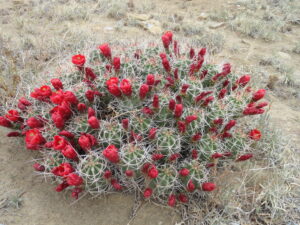 sagebrush, cactus and occasional juniper trees dotting the horizon. Yet this was the desert environment I had lived in most of my life that made me conscious in a way a more lush, wet world did not. The sound of a single bird singing, a drop of rain or trickle of water, the flash and wiggle of a lizard tail–here in the desert they reminded me not to take life for granted–all my thoughts and actions were consequential.
sagebrush, cactus and occasional juniper trees dotting the horizon. Yet this was the desert environment I had lived in most of my life that made me conscious in a way a more lush, wet world did not. The sound of a single bird singing, a drop of rain or trickle of water, the flash and wiggle of a lizard tail–here in the desert they reminded me not to take life for granted–all my thoughts and actions were consequential.
At the campground I set up tent and gear, checked in at the visitor center and headed out into the canyon for a first walkabout, which I decided would be the high mesa ledge overlooking the massive ancient site of Pueblo Bonito. Getting there involved a long walk and a tricky climb 150 feet up through a narrow slit in the sandstone walls. All the while, there was a persistent and painfully persistent jabbing in my stomach. Pain or no pain, though, I was not going to miss out on this time in Chaco.
I clawed my way up and onto the mesa ledge and emerged onto the sandstone ledge like a newborn baby who has struggled his way out through the birth canal. It was afternoon and the light was as mild as the temperature. From the ledge I could see much of the canyon below and miles in the distance beyond. 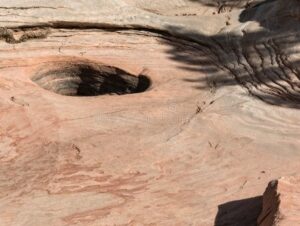 The mesa ravines supported wiry bunch grass, cliff roses wafting an occasional sweet fragrance, an array of desert wild flowers and Apache plumes now fluffy with seed pods illuminated like bright lights in the late afternoon light. Rocky erosional pathways were exposed like large veins in a human hand. Mysterious circular holes in the sandstone ledge looked human made and left me wondering about who, what and when.
The mesa ravines supported wiry bunch grass, cliff roses wafting an occasional sweet fragrance, an array of desert wild flowers and Apache plumes now fluffy with seed pods illuminated like bright lights in the late afternoon light. Rocky erosional pathways were exposed like large veins in a human hand. Mysterious circular holes in the sandstone ledge looked human made and left me wondering about who, what and when.
This was the path of the ancients I trod, the route so many walked by foot for hundreds of miles to the Center Place, this canyon where thousands of rooms in ancient pueblo buildings had been carefully constructed in alignment with heavenly cycles of sun, moon and stars. I wondered if I was part of an ongoing drama, coming here to help find my own center place to ground myself in my daily life. There was a digital world wide web where I spent many waking hours connecting to others electronically, but where was that center place where I could rest and find relief in the sacredness of the everyday? Chaco Canyon had been one such physical place for me over the years, a place of vast silence that evoked in me a sense of the awesome interconnectedness of all.
As I walked, breathing in the morning silence, I noticed a bit of crumbling red sandstone on the trail, and wondered if it might have served as paint for the exquisite Chaco pottery made hundreds of years ago. Kneeling down, I wet it with saliva on my index finger to determine the color and texture; then without thinking, licked the red earth again, like licking the sweet batter on my mother’s spatula at home when she was baking a cake. It was rough, sandy and not at all like cake batter. But for some inexplicable reason I repeated the procedure. More licks of the earth batter. Within minutes, my stomach pain vanished. How? Why? I had no explanation, but a poet once said, “Sometimes the most important thing is the most inarticulate.”
Native American Acoma Pueblo poet Simon Ortiz, expresses it this way in his poem “Canyon de Chelly”: https://lecuona.weebly.com/uploads/5/9/1/1/59118557/mi_madre_canyon_de_chelly.pdf
Lie on your back on stone
The stone carved to fit
The shape of yourself.
My son is near me.
He sits and turns on his butt
and crawls over to stones,
picks one up and holds it,
and then puts it in his mouth.
The taste of stone.
What is it but stone,
the earth in your mouth.
You, son, are tasting forever.
At that moment I became part of the place and was given a gift from the canyon. That night, another gift: I drifted to sleep to the sound of drumming and chants nearby in the campground. Then a dream: I watched a man (was it me?) ceremonially offer cornmeal to people gathered in a circle, inviting them to volunteer their service in some way. I awoke during the night just as a waning moon rose above canyon walls–orange-gold, beautiful, complete silence in the campground. Later that night I drowsily awakened again under a blanket of infinite stars and watched a meteor trail across the vast canopy. I thought: “This is why I come to Chaco. To reconnect with my home in the stars.” Then, an even larger meteor blazes across the darkness, as if to answer, “yes.”
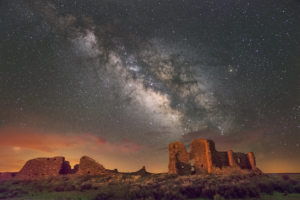
After breakfast, I joined Guatemalan elder Don Alejandro for teachings on that fall equinox day. His words of wisdom still ring in my heart, as true to me today as they were then: What are you doing here? Why am I here? Each one of us, we travel to different parts of the world. But what are we looking for? We are looking for love and understanding among all beings that inhabit the Earth. We are searching for something in our minds for what we can do to defend Mother Earth.”
——————————————————————————-
May 23, 2007: I sat and shed tears of sorrow, shame…for what I was not sure. I was working for the Santa Fe Public Schools as the emergency management and crisis response director and for the second year in a row had applied to the U.S. Department of Education for a large grant to bring our schools up to national standards. I knew it was well written and worthy of funding….and I also knew I failed to include a required sheet of paper that could result in rejection. It was too late to add the missing paper and I had to mail the proposal. I felt I had let down the schools, my community, state, the world! Maybe this was not the work I should be doing, I agonized. And yet, as I drove from the post office in abject sorrow, I prayed: I need, and this application needs, a miracle to survive the heartless, objective “bean counters” at the federal level. Just at that moment a CD in my car that had been stuck for days in the player began to play. The speaker on the recording was saying that ALL of us make mistakes and God loves us no matter what our mistakes. I took it as a sign that perhaps a miracle could happen for the grant application. But–and a big but it was–I was still ashamed of my oversight of the missing piece of paper and was not forgiving myself.
Two days later I arrived at Chaco Canyon to a spectacular technicolor sunset. I was on a solo trip planned weeks before, but I didn’t know then how much I would need this time alone. Others wanted to come but no one could. Perhaps I was supposed to be here on my own to find some peace and comfort from the grant application ordeal.
The first morning I climbed the trail to a mesa above the campground for a sunrise meditation and read the words of East Indian spiritual leader Paramahansa Yogananda from an article entitled “Ridding Yourself of Worries:” “Worry takes time and energy. Use your mind instead to make some positive effort…every time you worry you put on a mental brake and in struggling against that resistance you place a strain on your heart and mind…remember there is someone on this earth suffering 100 times more than you are…if you do your best, God will reach down his hand to help you….” Good advice, but my mind still had the brakes on, preoccupied with the grant application.
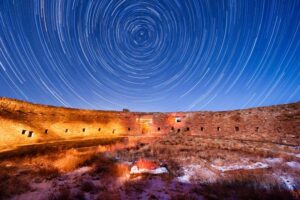
Casa Rinconada
Late afternoon I headed out for a walk from the monumental kiva (underground ceremonial structure) of Casa Rinconada on the south side of the canyon. At this site almost 20 years ago I experienced the awesome mystery of Chaco. I was guiding a group from the Institute of Noetic Sciences and though it had begun to snow, many of us happily hopped off the van and up the trail to Casa Rinconada. We were able to sit inside the huge kiva on low lying walls rimming the circular structure and take a few moments of quiet, despite the swirling snowflakes and chilling wind. My eyes were closed in meditation when something inexplicable occurred. First, my inner vision filled with a bright golden light. Then I felt a warm glow flow within and around me. As soon as it came, it left and I opened my eyes and led the group back to the waiting van.
That night the others who had sat in the kiva shared that they too had the same experience as I did. Just a fluke occurrence? A collective delusion? Casa Rinconada was for hundreds of years was likely filled with prayers for rain and sustenance. Community gatherings offered songs to thank the gods for corn and crops. As it seems today in Pueblo life, prayers probably invoked the guiding presence of unseen spirits. Chaco is a thief of time, a place that marks the passage of time in its celestial architectural alignments and a place where all of time is present in the moment. I believe that our group was in the inexplicable presence of the ancient ones in that kiva “snowbowl,” an invisible presence that could not be spoken, paraphrased or translated into any language. In “The Little Prince,” St. Exupery said it this way: “What is invisible to the eye is truly important. It is with the heart that we truly see.”
It was from this great kiva where I began my solitary walk this late spring afternoon. At least two major roads perhaps a thousand years old connect to the site from places many miles distant. The little trail I followed went around the mesa through a large opening called the South Gap. It was just me and the raucous ravens, an occasional scuttling lizard and the wind whipping itself into a drumbeat in my ears. I gathered a few fresh spring sagebrush branches to make prayer bundles for friends, and inhaled a deep awakening breath of the fresh pungent aroma. At the mesa I ascended a zig zag trail up the side. I had been here before, but this time the going was slower, the trail up seemed steeper. I was carrying more than my little day pack. I carried an emotional burden of shame and sorrow from the woes of my grant application.
Eventually I was on top of the mesa, a windswept sandstone saddle. It was a stunning view to western horizon–perhaps thousands of acres of red-orange globe mallow plants in bloom, glowing brightly from late afternoon sunlight like a red ocean with an interplay of light and clouds–grey, blues, whites amidst the rest of the spring green landscape. The panorama was vast, bordered by the Chuska and Lukachukai Mountains 50 miles to the west. As I gazed quietly at the oceanic desert spectacle, a dream from long ago came back to me: In the dream I was standing cliffside by the ocean as a truly wise person next to me motioned with his arm sweeping from one side of the horizon to the other, saying, “THIS is who you TRULY are!” Now at this moment in this reality, from the heart of Chaco to my own heart, I heard within myself these words:
“You are NOT a piece of paper nor a job description, not a human doing. You are a human becoming, perfect in his imperfection!”
Awestruck, I backed away up the mesa from one step at a time, keeping the view to the west in a solid gaze. Up the trail, over rocks, ledges, tree roots one step at a time, backwards. Then awe became celebration as I cried in joy, hopped, skipped and jumped realizing that the self-imposed burden of my week’s disappointment regarding the grant application had been lifted. I realized that the grant application was just the apparent source of my distress. Down deeper it was internal issues of feeling “I am not enough” or “I should be doing better.” But “better” was never enough. Now, thanks to the “spirit of place” and Chaco Canyon, I knew that no matter the outcome of the grant, I was heading home, a “human becoming” more whole and happier.
The application was not approved. But the next year, on my third try, we secured $250,000 to do the much-needed emergency preparedness work for Santa Fe Public Schools.
—————————————————
August 10, 2012: I was on another personal retreat at Chaco Canyon. I tried to come in June, but was stopped in my tracks when my home was broken into. That day I returned home to pack up and leave for the trip. Entering the house, I saw the patio door curtains blowing a bit in the breeze and thought, “I left the door open while I was away on errands.” Then I saw the shattered shards of glass and the large rock hurled through the double pane door scattered on the floor. My plans for Chaco were shattered as well. It took over a week and hundreds of dollars to get a new glass door from the Colorado manufacturer.
That whole year had been a tough time personally and also in my community and the nation. Just like the rising hot temperatures, burglary rates were skyrocketing in Santa Fe. Fires raged throughout the western U.S. and Denver set record high temperatures. A fire near Colorado Springs consumed over 300 homes. The mid-Atlantic states sweltered under a record breaking 104 degrees and Washington, D.C. declared a state of emergency due to huge damaging winds. Close to home, my kitty companion of nearly 20 years was not eating much and was uncharacteristically staying outdoors a good deal of the time. It was possible that she had a failing kidney.
So, this solo sojourn to Chaco was a needed retreat. I started the day at Socorro Herrera’s Cafe in Medanales north of Espanola, enjoying breakfast with Tio Manzanares. Tio and my path crossed at Ghost Ranch Presbyterian Conference Center in the early 1990’s where I was teaching a retreat called “Earth Walks: The Spirit of Place.” He was giving talks to Elder Hostel groups, mostly about his time working for 12 years as a young man for artist Georgia O’Keefe. At a meal together in the Ghost Ranch dining hall, I quickly learned that he had much more to share than just his tales with the famous “Miss O’Keefe” as he called her. His stories of artists, aliens and angels left me alternately spellbound, skeptical or rolling in laughter but always I felt the good-hearted nature of this man who had spent most of his life in the Abiquiu area north of Santa Fe.
It was hard work, but for much of his life Tio was a stone mason, building walls and other structures in the nearby villages. That meant collecting lots of stones–8.900 truckloads to be exact, wearing out 42 trucks over the years from 1972-1994, he said. Seems like he had collected as many stories as stones, but he was given some advice about stone collecting that could well apply to storytelling.
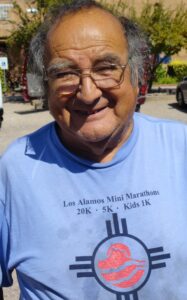
“Tio” Manzanares
“An Indian friend told me that some of the stones were not supposed to move from their spot,” Tio shared. “First I thought a rock doesn’t have any understanding. Then sometimes my truck would break down for some reason. Once I caught on and figured out that those stones were not intended to move, I didn’t have a problem. And the rocks were gentler to me. I didn’t smash my fingers as often and I could move the stones more easily.”
On one occasion his truck did break down on a late winter afternoon in an isolated arroyo where he’d been traveling. Light was fading and so was the temperature. It was far from home and Tio was worried about what to do. For a minute, he thought he heard sounds of a car. Climbing the hill above he saw headlights heading towards him. The car shortly arrived and a man stepped out, asking if Tio needed help.
“Who are you? Where did you come from?” asked Tio, totally mystified at the stranger who appeared seemingly out of nowhere.
“I’m just helping out people who get stranded,” he replied. “And I’m from a place you wouldn’t even know about.” With that, the man went to his car and pulled out the exact tools and parts needed to fix Tio’s truck, parts that would have required a trip into town to purchase.
“Maybe that stranger who helped me on the road was Saint Jude,” Tio mused. Towards the end of his stonemason career, Tio smashed his hand severely and he cried out to Saint Jude in pain, “If you think you can change my life, do it!” Saint Jude is the patron of hopeless causes and despair. In a week Tio had a new job and quit the stone mason business. Ever after, he kept a lighted candle at the foot of his Saint Jude statue. In any case, after the truck was repaired, the man got into his car, backed up, turned around and left. Tio quickly climbed the small hill again to watch him leave…but there was no sign nor sound of a car in any direction.
Tio and I were about done with the breakfast of good and hot New Mexico huevos rancheros (spicy red and green chili–I always ask for “Christmas”) when Socorro, who managed the cafe stopped by with the check and a smile. She and Tio were mariachi singers and musicians “back in the day,” and it was a delight to see them recount those times. Tio said she was an award-winning diva of northern New Mexico songs. Socorro had her own stories to tell, some of them filled with the flutter of angels’ wings and miracles.
One day she was in the cafe early, preparing a huge catered meal order. It was just her alone, without staff help that day, and the clock was ticking. This was a big deal order, which could lead to much more needed business. But how was she to get it all done in time? The answer to that was doing the thing she knew best: prayer. She walked to the wall where an image of her patron Saint Socorro (Perpetual Help) overlooked the cafe.

Socorro Herrera at her restaurant in Hernandez, NM
“I can’t do this by myself!” she cried to the saint. “I need your help to get this done in time.” And then time stopped. Socorro swore that every time she looked at the clock, the hands had only budged a fraction and indeed, she finished the order and was out the door to deliver on time.
It was time for me to get on the road again. Traveling west, I circled around the great Jemez Mountain range through the towns of Abiquiu, Coyote, Gallina. Looming large on the left horizon was Tsi Ping, or Pedernal as the Spanish called it. Tsi Ping in the Native American Keres language means “flaking stone.” Reportedly there was a large obsidian mine from which tools and implements were traded for hundreds of miles away. The Spanish word means “flint.” Years before, I discovered an amazing summer solstice alignment with Tsi Ping and the setting sun, seen from the Puerto Nambe area in the high country above Santa Fe. That is the subject of another Earth Walks blog entry. For Georgia O’Keefe, the mountain held special significance. She was reported to say that if she painted the mountain enough times (as she did with a mysterious ladder above it in the sky along with a half-moon), she would become one with the mountain and it would be “hers.”
The mountain felt like “mine” on this day as I once again traveled past it. Years before, I climbed the peak, and felt a strong energy that evoked the unseen presence of something I could not quite name at the time. On this day it felt like a directional sign post and good friend waving to me on my journey to Chaco.
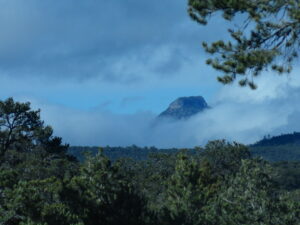
Tsi Ping or Pedernal Peak in the mist
I needed a friend because I feel like a refugee, escaping from a troubling work situation with the Santa Fe Public Schools. Close to the canyon the cell phone unexpectedly buzzed with a message from the job. I recoiled and contracted, like a cornered snake that had gone into defensive posture. But then I thought to myself, “Keep your protective spirit shield firmly in place and do not contract in fear of change or new conditions, requirements and adaptations around you. Say ‘yes!’ to all that does not compromise your core values.” And with those words, I arrived in the canyon.
Chaco was still the same bone-dry desert ecology that always seemed so inhospitable to human habitation. It was brutally hot that day, but like every desert, Chaco took getting close to the ground to see the complexity of life that does exist. Ancient cultures utilized beeweed, pinon nuts, rice grass, cactus fruit and other native plants for food, then later cultivated beans, corn and squash. This trio was known in Native America as the “Three Sisters.” When planted together, they worked to help one another thrive and survive, a good metaphor for any community. (See http://www.nativeseeds.org/learn/nss-blog/415-3sisters ) For my food, I foraged through the aisles off my local community natural foods co-op store in Santa Fe which did a good job helping its members thrive and survive.
Later in the day in camp, I sat in the only available mottled shade of nearby low growing cliff bushes and created prayer sticks for friends facing challenges as well offerings to my home. The sticks were decorated with yarn, feathers and other found objects. While they were made, they were imbued with positive thoughts and intentions and then planted in the earth outdoors where winds carried their prayers to all the directions. Kind of like prayer flags in the Buddhist tradition. Creating them in silence was a kind of meditation. I sat, knees bent, “feet standing,” silently winding colored yarn onto the sticks.
I learned how to make the “ofrendas” or offerings from a woman named Maria Elena. She was of Native Mexican Huichol ancestry and had the gift of being a “dream healer,” which meant she could enter into the dream world of a person and offer help and interpretation. As a young child in Los Angeles, where her Mexican parents had immigrated, she occasionally found herself in that dream world, seemingly floating above her bed and having other unusual experiences. Experiences that her parents did not want her to have, as they had immigrated to the U.S. to forge a new and hopefully more prosperous life. So, they put her in parochial school to help her forget the old ways. But Spirit will have its way, no matter where we are.
At school, Maria Elena made friends with a school maintenance man and together they went out to the desert and did prayer and ceremony, helping to further deepen her healing abilities. This secretive time in ceremony and prayer helped her make sense of her natural talents. Maria Elena said that if she had been living in her Huichol community in Mexico, the elders would have recognized her gift and taken her to be trained in the ways of their people. Fortunately for me and many others, she did not lose that gift and indeed was willing to share her healing ways.
I thought of her now at Chaco and acknowledged the gift of her teaching. As I sat in calm, silent gratitude a two-foot snake unexpectedly and quietly sl
id her way under my legs. It was a total surprise, yet in another way it wasn’t, since I’ve had so many encounters like this in nature. I stopped working on the prayer stick as the snake stopped among the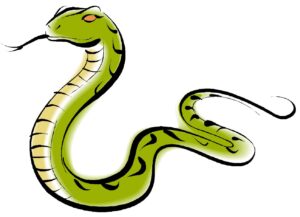 colored balls of yarn and feathers. She looked up at me and blinked. I winked back, neither of us expressing any trepidation. Chaco had always shared its mysteries and magic with me, and this was another one of those moments.
colored balls of yarn and feathers. She looked up at me and blinked. I winked back, neither of us expressing any trepidation. Chaco had always shared its mysteries and magic with me, and this was another one of those moments.
For some indigenous cultures, the snake is the most sacred of animals as she travels with her heartbeat so close to that of Mother Earth. In the system of Medicine Wheel earth astrology by Sun Bear and Wabun, my totem animal is the snake. https://www.simonandschuster.com/books/The-Medicine-Wheel/Sun-Bear/9780671764203 Unlike many European concepts of the snake, in Native America this creature is revered for its power of transformation. The shedding of skin is a powerful metaphor for our ability to transform our innermost being, bringing the lessons we learn in life into harmony. And the snake has something else special to teach–it is the only creature that travels through life with its heart in close contact with the earth.
I reflected on all of this as I bumped along the washboard dirt road from Chaco, thinking about the snake’s advice to experience the world willingly and without resistance. Sun Bear and Wabun wrote, ” (the shedding of Snake’s skin)…is the knowledge that all things are equal in creation and that those things which might be experienced as poison can be eaten, ingested, integrated and transmuted if one has the proper state of mind…which can bring about a balance of passion, vitality, dreams, leadership, wisdom and resolution.” That certainly would help in my job challenges, so I resolved to be more like the snake and stay close to the ground, listening to the messages of my heart and that of mother earth.
 have made their way here over millennia. Both solar and lunar cycles were integrated into the architecture http://www.solsticeproject.org/lunarmark.htm and huge building sites were in alignment with each other over many miles. Great straight roads radiated out from the center of the canyon to distant outlying settlements. https://en.wikipedia.org/wiki/Archaeoastronomy#Chaco_Canyon
have made their way here over millennia. Both solar and lunar cycles were integrated into the architecture http://www.solsticeproject.org/lunarmark.htm and huge building sites were in alignment with each other over many miles. Great straight roads radiated out from the center of the canyon to distant outlying settlements. https://en.wikipedia.org/wiki/Archaeoastronomy#Chaco_Canyon Earth Walks support staff, Sharon and Tina Guerrero, have Indigenous historical family roots in northern New Mexico and southern Colorado.
Earth Walks support staff, Sharon and Tina Guerrero, have Indigenous historical family roots in northern New Mexico and southern Colorado.

